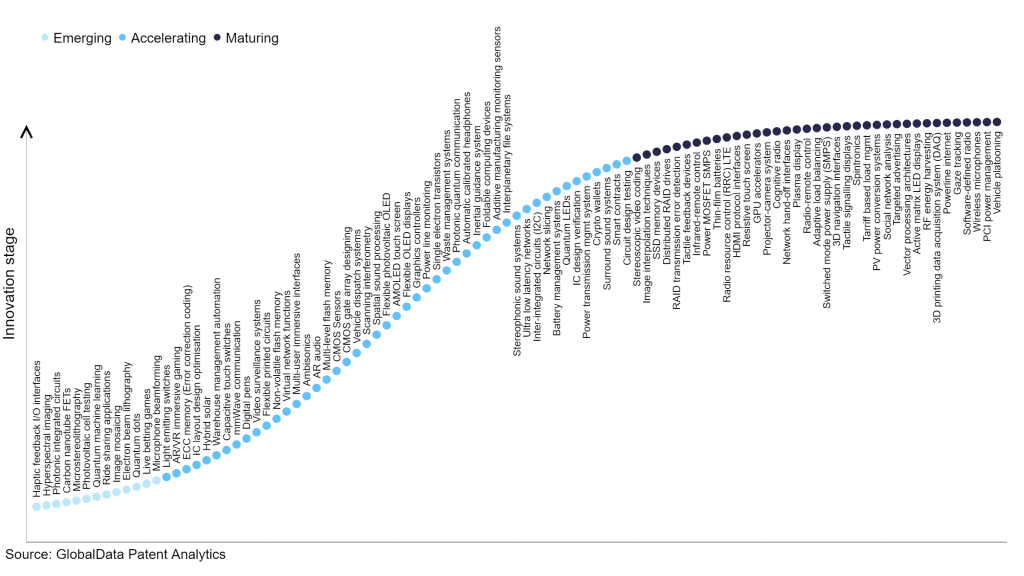The technology industry continues to be a hotbed of innovation, with activity driven by increasing demand for assistive technologies, the need for improved accessibility in various industries, and advancements in haptic technology, enabling more realistic and precise tactile feedback experiences. This will grow the importance of technologies such as haptic actuators, sensors, pattern recognition algorithms, and control systems. In the last three years alone, there have been over 3.6 million patents filed and granted in the technology industry, according to GlobalData’s report on Technology Innovation: Tactile signalling displays. Buy the report here.

Access deeper industry intelligence
Experience unmatched clarity with a single platform that combines unique data, AI, and human expertise.
However, not all innovations are equal and nor do they follow a constant upward trend. Instead, their evolution takes the form of an S-shaped curve that reflects their typical lifecycle from early emergence to accelerating adoption, before finally stabilising and reaching maturity.
Identifying where a particular innovation is on this journey, especially those that are in the emerging and accelerating stages, is essential for understanding their current level of adoption and the likely future trajectory and impact they will have.
300+ innovations will shape the technology industry
According to GlobalData’s Technology Foresights, which plots the S-curve for the technology industry using innovation intensity models built on over 2.5 million patents, there are 300+ innovation areas that will shape the future of the industry.
Within the emerging innovation stage, microphone beamforming, live betting games, and quantum dots are disruptive technologies that are in the early stages of application and should be tracked closely. Circuit design testing, smart contracts, and surround sound systems are some of the accelerating innovation areas, where adoption has been steadily increasing. Among maturing innovation areas are, vehicle platooning, peripheral component interconnect (PCI) power management, and wireless microphones, which are now well established in the industry.
Innovation S-curve for the technology industry

Tactile signalling displays is a key innovation area in technology
Tactile signalling displays are devices designed to offer users tactile sensations as feedback. They are commonly utilized in environments where visual and auditory feedback may not be suitable or accessible, such as public spaces and sensory rooms for individuals with disabilities. Vibrating surfaces, pressure-sensitive mats, and other tactile stimulation devices are among the typical examples of tactile signalling displays.
GlobalData’s analysis also uncovers the companies at the forefront of each innovation area and assesses the potential reach and impact of their patenting activity across different applications and geographies. According to GlobalData, there are 50+ companies, spanning technology vendors, established technology companies, and up-and-coming start-ups engaged in the development and application of tactile signalling displays.
Key players in tactile signalling displays – a disruptive innovation in the technology industry
‘Application diversity’ measures the number of different applications identified for each relevant patent and broadly splits companies into either ‘niche’ or ‘diversified’ innovators.
‘Geographic reach’ refers to the number of different countries each relevant patent is registered in and reflects the breadth of geographic application intended, ranging from ‘global’ to ‘local’.
Immersion is a leading patent filer in tactile signalling displays. One of the company’s patents describes a haptic representation that produces a haptic effect based on sensor input. The sensor input is converted into a haptic signal, which is then transmitted to an actuator. The actuator uses the haptic signal to generate the corresponding haptic effect.
Other prominent patent filers in the space include CEA and Nokia.
By geographic reach, Shenzhen O-film Tech leads the pack, followed by Daesung Electric and Inventus Engineering. In terms of application diversity, Parker Hannifin holds the top position, followed by Abbott Laboratories and Meta Platforms.
Tactile signalling displays play a significant role in enhancing accessibility and communication for individuals with sensory impairments. By providing tactile feedback, these displays enable effective information transmission and interaction, improving the overall user experience and inclusivity in various environments.
To further understand the key themes and technologies disrupting the technology industry, access GlobalData’s latest thematic research report on Technology.
Data Insights
From

The gold standard of business intelligence.
Blending expert knowledge with cutting-edge technology, GlobalData’s unrivalled proprietary data will enable you to decode what’s happening in your market. You can make better informed decisions and gain a future-proof advantage over your competitors.







